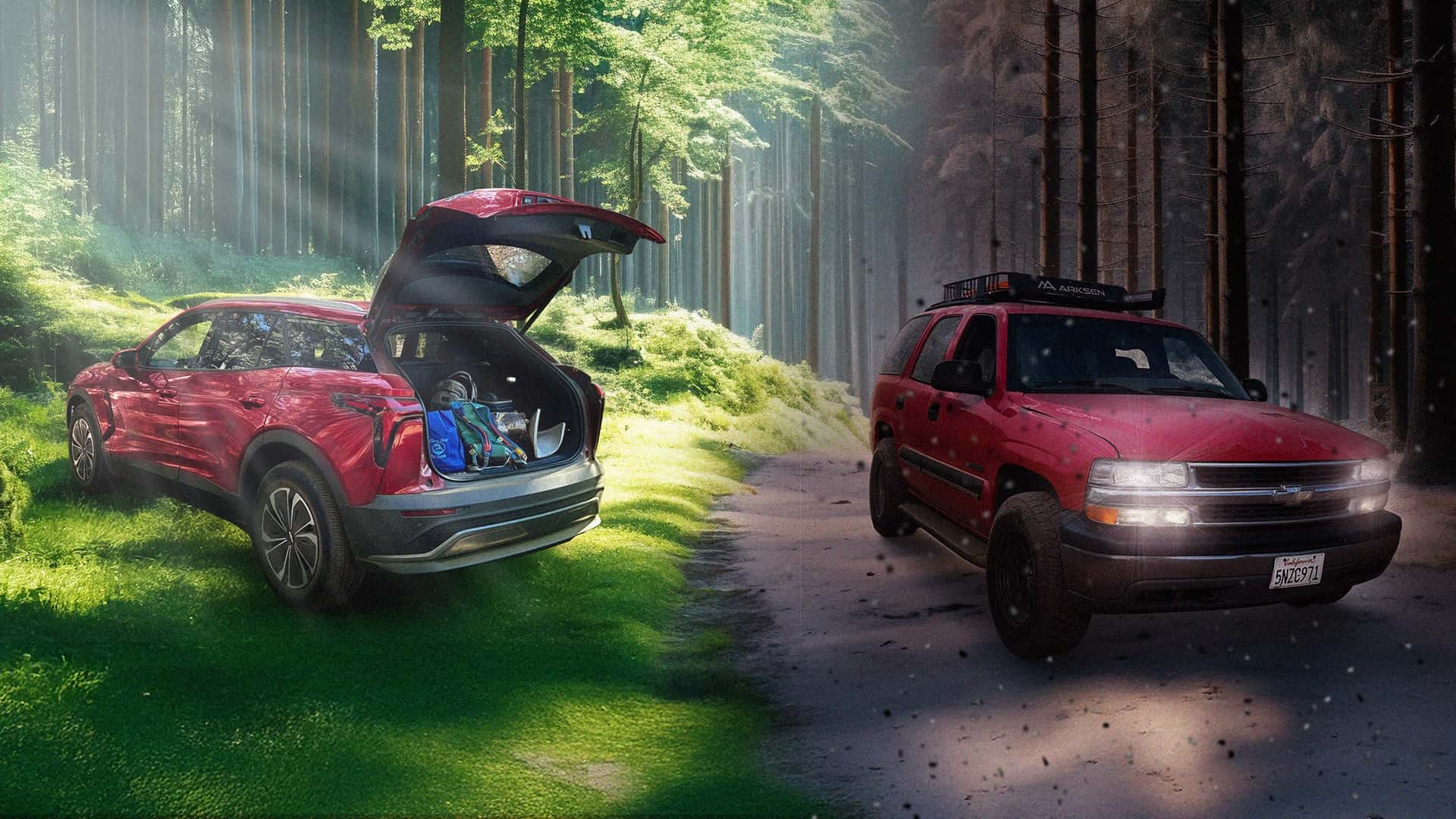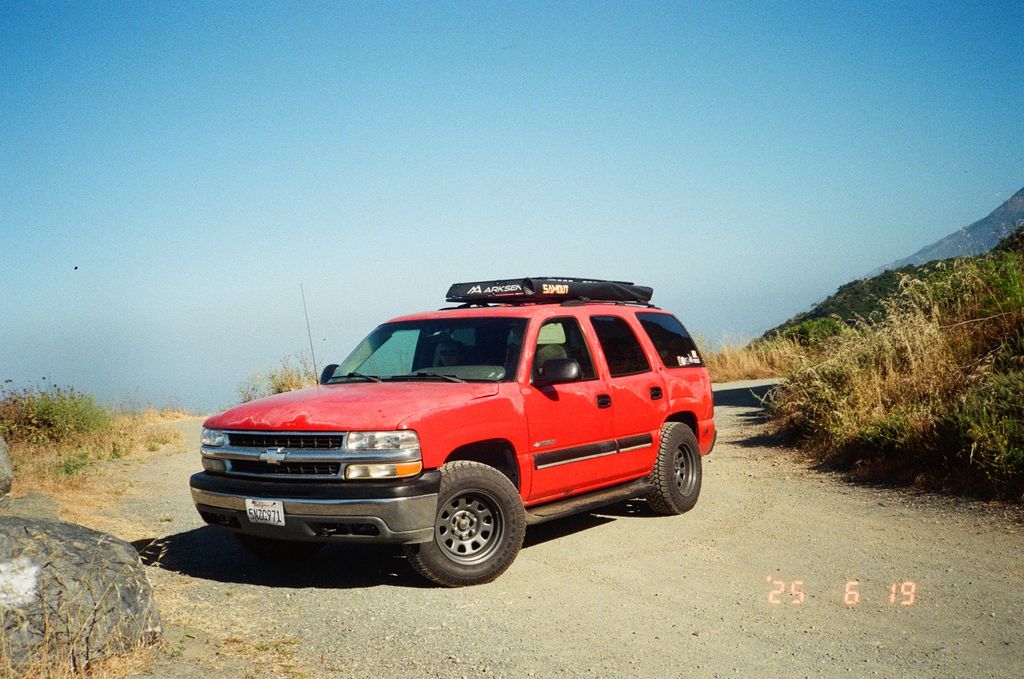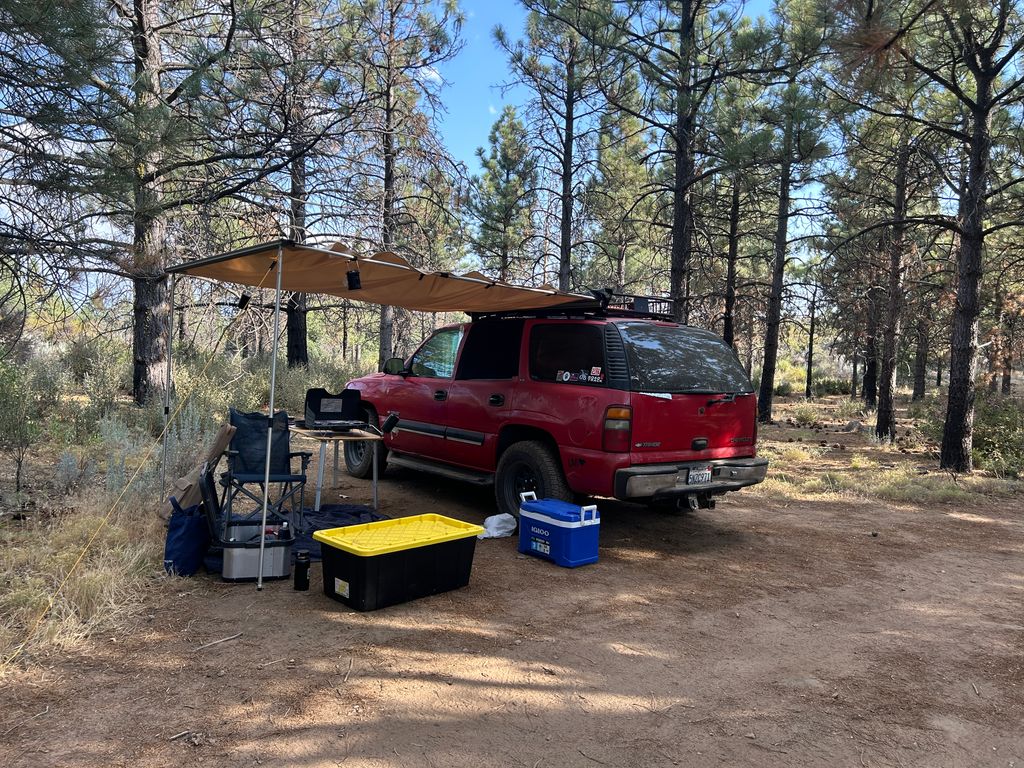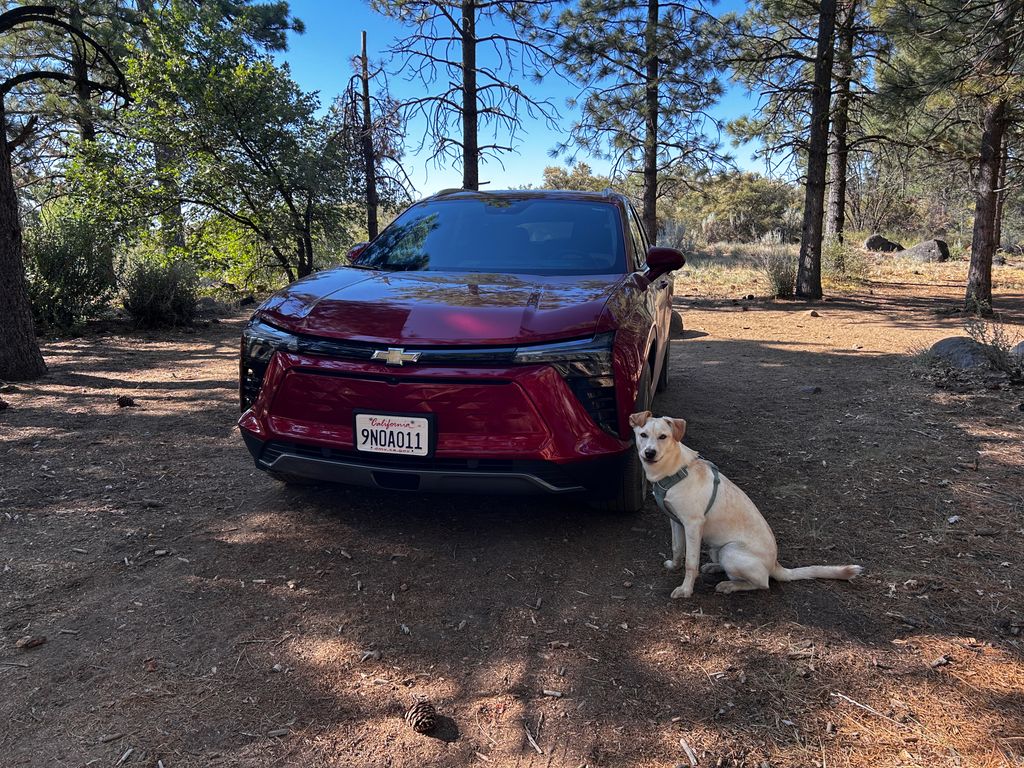
One year ago, I leased a 2024 Chevy Blazer EV. With eight inches of ground clearance, plenty of cargo space and 278 miles of range, it’s practical enough to handle all of my daily needs. I noted in the post, therefore, that I’d be selling my gas-guzzling 2001 Chevy Tahoe.
A year later, I still haven’t gotten rid of the Tahoe. It’s a 233,000-mile, faded-paint hunk of junk. And I just can’t quit it. For a lot of people, the electric vehicle they may want just doesn’t exist yet. Let me explain.

Why Trucks Rock
This weekend, I was sick of the city, and of other people. I spent 20 minutes loading the truck and drove out to Cleveland National Forest, where I pitched camp a few miles off pavement. I had about 10 acres of public land to myself for the night and, despite the heat, slept comfortably in a big, insulated cabin: the back of my Tahoe, Big Red.

See, when Chevy sold this truck back in 2001, the promise of a V8 4x4 truck was simple. You can go anywhere you’d like, with whatever you want to bring, forever. That’s a helluva pitch, and one Big Red has delivered on: After 25 years, it’ll still go anywhere in the backcountry that I point it at.
Sure, the spot I slept in this weekend was reachable with a modern AWD SUV. But given that a normal modern SUV costs around $50,000, I certainly wouldn’t have charged down the overgrown service roads I explored before setting up camp.
My Blazer EV also likely couldn’t handle these same roads when they’re wet. With no spare tire and no ability to be flat towed, it’s also not really a safe option for deep off-pavement excursions. Plus, while I can certainly camp in the Blazer EV, I wouldn’t have the space, security or comfort that comes from a giant, flat load floor with tall ceilings.

A truck for me is therefore a want, not a need. I don’t need to explore the desert. I don’t need to do three-day off-grid trips through Big Sur with my girlfriend and dog. But I like to. And by having the truck around, I have a constant tie to those places. The knobby tires and roof rack remind me that there’s a whole world waiting out there, one with rocky, brushy trails and creek crossings, one where I can carve out my own slice of America’s best public land.
I can do it in 100-degree high desert heat or 20-degree Alpine nights, and know my Tahoe is going to offer me a comfortable, insulated, spacious camper experience with no real set-up. It’s a dream scenario, and with a reliable platform and cheap parts, it costs me almost nothing to keep.
I’d love the electric version—a Rivian R1S is better in every way—but it’ll take $80,000 to get one into your driveway.

The Truck Owner's Dilemma
The main problem for me is the cognitive dissonance. I’m the deputy editor of one of the world’s largest EV publications. Yet if I could only keep one of my vehicles, well, it’d be the one with the V-8. A small part of that is practical: To charge at home, I have to run a 10-gauge extension cord 30 feet to the street, partially obstructing a sidewalk. But the main reason is that the automotive industry sold me an Emotional Support Truck, and I can’t live without it quite yet.
These companies have done an incredible job of convincing Americans that a truck is a necessary part of a fulfilled adult life. I’ve been pitched this story since I was a child, demanding my dad take me to the Toyota dealership so I could simply sit in the new 2007 Tundra. I remember every pickup truck my family ever rented. I remember ogling the new Tahoes as an 18-year-old Chevy salesman back in 2018. The time I borrowed an F-250 Camper in Yellowstone literally changed the course of my life.

I’m a believer. I know that American trucks are excessive, and that they’re killing pedestrians at alarming rates and that our obsession with them is hurting the climate. But it’s also ok to accept that they are part of the world we live in. The average American vehicle today is 12.6 years old, which means even if we banned new gas trucks today, we’d see them on the street well into the 2040s.
The fact is, people are going to do these adventures in the vehicles they can afford to buy. I’d love to be wheeling a Rivian or out on the trails in a Silverado EV Trail Boss, but I refuse to believe that the best thing I can do for the environment is to spend $80,000 on a truck that I’d be terrified of scratching.
When beat-up old Rivians, GMC Sierra EVs, Ioniq 5 XRTs and Blazer EVs are $12,000, then we’ll have the affordable, electric adventure rigs we all want.

For now, rejecting that desire for something nice, new and respectable is part of the joy of owning Big Red. I’ve driven all over the world in six-figure cars, and yet all of the best road trips of my life have been in 200,000-mile trucks. Wheeling is simply more fun when the financial stakes are lower, and off-road capable long-range EVs and crossovers haven’t gotten that cheap yet.
Why It’ll All Work Out
But we try to judge EVs as a technology not by where they are now, but where they’re headed.
All of my love for gas trucks is predicated on one core tenet: They are the cheapest, best option for exploring the great outdoors (unless you want a motorcycle, which is a much cooler option for fans of premature mortality). Once off-road EVs mature and proliferate, they will easily best gasoline trucks in most use cases.
At the very least, the relative simplicity of electric off-roaders will make them superior options for a buyer base that prizes durability above all else. EVs like the Model S and Model 3 prove that consistent, above-250,000-mile endurance is not just possible for EVs, it is likely to be the norm once automakers work out initial kinks.
A 25-year-old Ford F-150 Lightning will be 10 times the truck that Big Red is today; it just needs time to depreciate first.

EVs also solve the other main advantage of a traditional 4x4 truck over a crossover: low-end grunt. True four-wheel-drive vehicles remain superior off-road in part because they have dedicated “low range” gearboxes, which offer incredible low-end grunt for climbing steep, slippery surfaces. In those scenarios, an all-wheel-drive crossover is much more likely to struggle, potentially even overheating its transmission.
Most EVs do not have multi-speed transmissions, and they all provide their maximum torque output from a dead stop. That means you shouldn’t have to worry about low-end grunt in future EVs. You also won’t need to worry about moving parts in the engine rattling themselves apart, you won’t really have to think about managing the power in electronic devices like fridges and lights and you won’t have to carry spare fluids. It’s simpler.
Most importantly, EV off-roading is quiet. The Rivian R1S remains my favorite off-roader, not because it’s more capable than a Wrangler, but because it is a much more serene experience. You get to hear the sounds of the world around you, all with the knowledge that you’re not polluting the very planet you’re exploring.

With modern trucks offering over 400 miles of range and endless horsepower, it truly is a better overall experience. But it’s also priced like one, for now. A great modern electric truck will cost you at least $75,000 in the real world, and with the technology improving rapidly, it will likely be outdated quickly. Today’s electric trucks are good-enough options that owners already like; tomorrow’s will knock you on your ass.
But in the meantime, folks have to get by with what’s available today. For $5,000 with no payments, no stress and no status, I can go anywhere in the country and have my own private hotel. One day, I’ll do the same in some five-star software-defined EV with climate control and an integrated power system. For today, my crappy old truck will have to do.
Contact the author: Mack.Hogan@insideevs.com.







